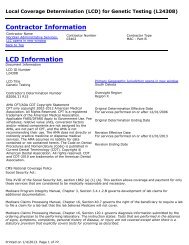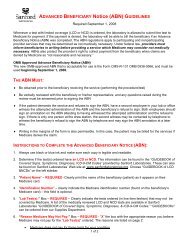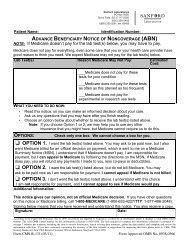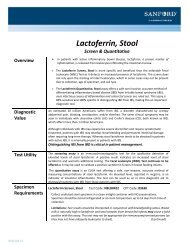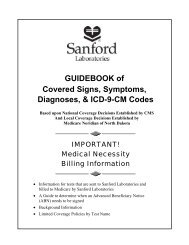aPTT VERSES HEPARIN ANTI-XA - Sanford Laboratories
aPTT VERSES HEPARIN ANTI-XA - Sanford Laboratories
aPTT VERSES HEPARIN ANTI-XA - Sanford Laboratories
Create successful ePaper yourself
Turn your PDF publications into a flip-book with our unique Google optimized e-Paper software.
ADVANTAGES/DISADVANTAGES<br />
OF APTT MONITORING<br />
Advantages<br />
• Inexpensive<br />
• Widely used as general screen<br />
• Long term use…”comfort zone”<br />
• Available 24/7 all labs<br />
Disadvantages<br />
• Relationship of heparin dose and<br />
heparin level not reliably predicted<br />
• Therapeutic <strong>aPTT</strong> with low heparin<br />
level = thromboembolism risk<br />
• Subtherapeutic <strong>aPTT</strong> with high<br />
heparin level = hemorrhage risk<br />
• <strong>aPTT</strong> does not reliably correlate to<br />
heparin blood concentration<br />
• <strong>aPTT</strong> does not reliably correlate to<br />
heparin antithrombotic effect<br />
• Variables—preanalytical, analytical, biologic<br />
• <strong>aPTT</strong> reagents vary in responsiveness to heparin<br />
• New therapeutic range with each<br />
lot of <strong>aPTT</strong> reagent (yearly)<br />
• New therapeutic range with any<br />
major change in <strong>aPTT</strong> system<br />
ADVANTAGES/DISADVANTAGES OF <strong>ANTI</strong>-<strong>XA</strong><br />
Advantages<br />
• Measures actual enzyme activity =<br />
reflection of heparin effect<br />
• Better correlation between anti-<br />
Xa activity and heparin level<br />
• More specific since it measures the<br />
inhibition of a single enzyme<br />
• Target better defined<br />
• 0.3–0.7 U/mL (UFH)<br />
• Fewer analytical errors<br />
Disadvantages<br />
• More expensive cost per test<br />
• Not available 24/7 in every lab<br />
• There is limited published information<br />
on the use of anti-Xa assays for routine<br />
monitoring of UFH therapy<br />
• Prompt sample processing (1 hour) is required to<br />
avoid heparin neutralization from platelet factor<br />
(Continued from page 1)<br />
It is collected when the blood level is at its highest level, about<br />
4 hours after a LMWH dose is given. Random and “trough”<br />
levels may be ordered if the doctor suspects that the patient<br />
may not be clearing the LMWH at a normal rate. In this case,<br />
the blood would be collected just prior to the next dose.<br />
A heparin level gives a quantitative result that can be compared<br />
to a therapeutic range (e.g. 0.3 to 0.7 units/mL) and is not<br />
affected by other conditions that prolong the <strong>aPTT</strong>.<br />
Principle of Anti-Factor Xa<br />
The activity of both UFH and LMWHs depends on binding to<br />
antithrombin. This binding induces a molecular change that<br />
dramatically accelerates its inhibitory activity. LMWHs primarily have<br />
anti-Xa activity while UFH has both anti-Xa and anti-IIa activity.<br />
The Xa inhibitory activity of antithrombin (AT) is increased in<br />
patients receiving either LMWH or UFH. This can be measured with<br />
a clotting-based assay or more commonly, a chromogenic assay.<br />
A standard curve is constructed by adding known amounts of LMWH or<br />
UFH to plasma and a fixed amount of Xa. This results in the formation of<br />
an inactive AT-Xa complex and the residual Xa is measured using either<br />
a clotting-based assay or chromogenic assay. The residual Xa activity is<br />
INVERSELY proportional to the concentration of heparin in the sample<br />
and may be quantitated from a calibration curve. The heparin used for<br />
preparation of the calibration curve should be the same heparin used<br />
for patient therapy at the institution, i.e., separate standard curves<br />
should be constructed for a specific UFH and a specific LMWH.<br />
(Continues on page 3)<br />
2



